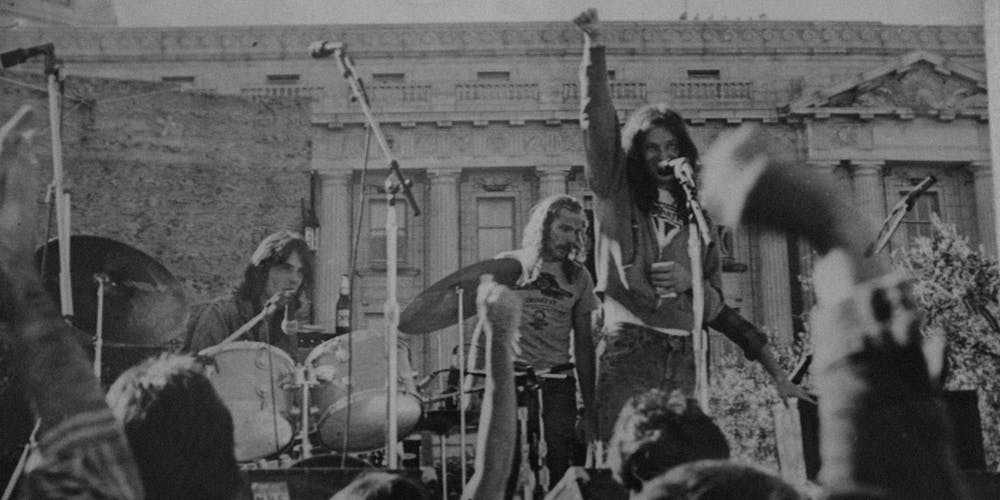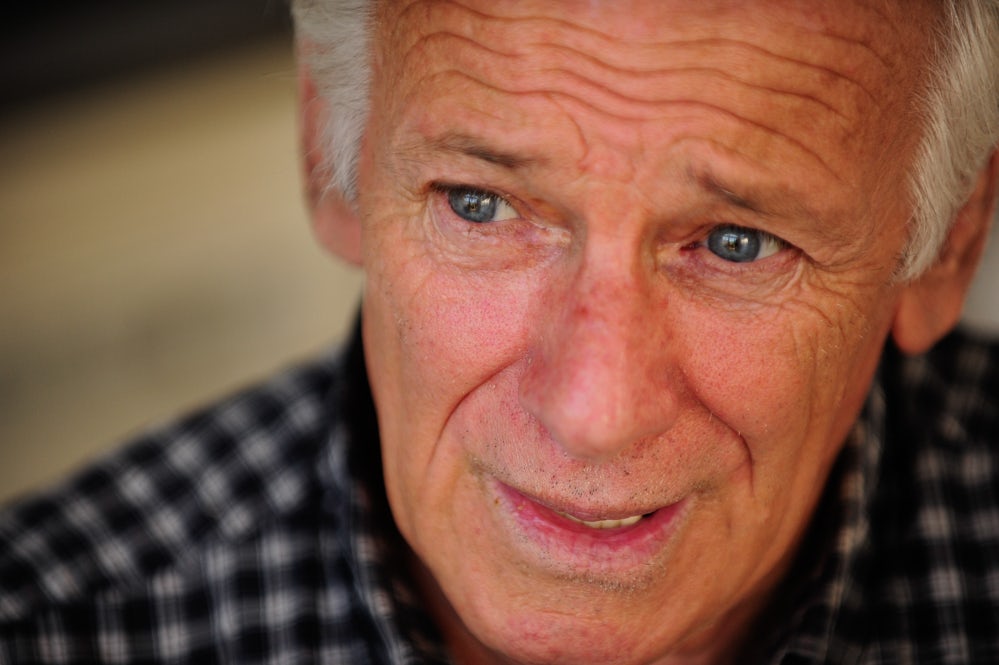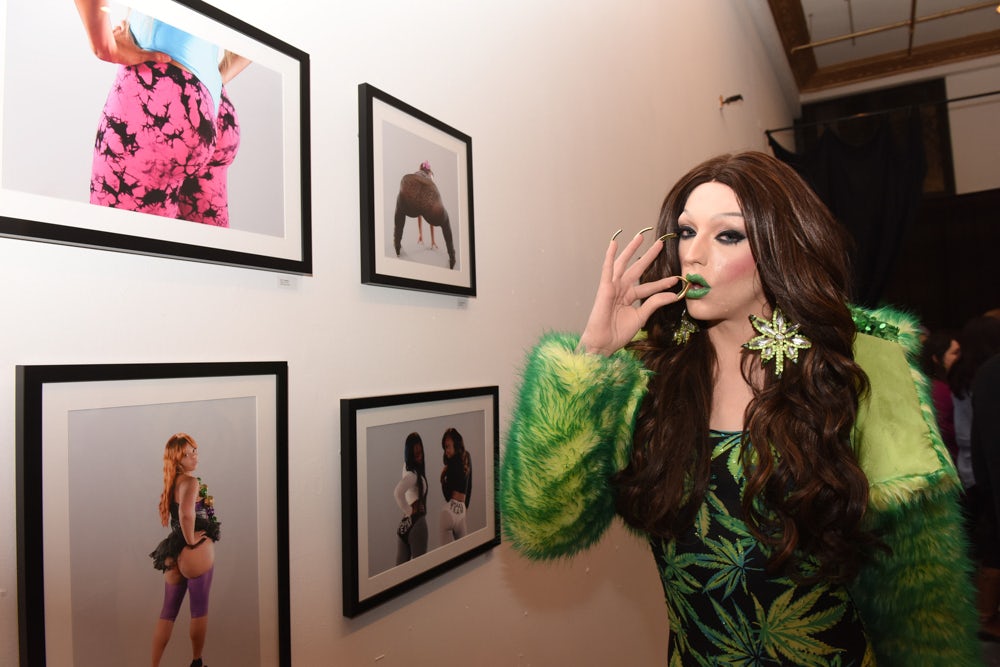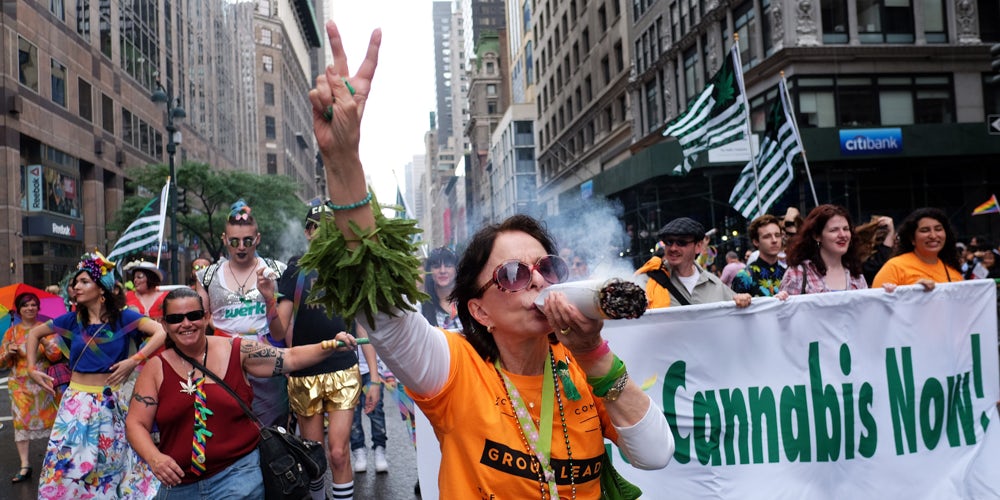
Dennis Peron is an openly gay American medical marijuana and LGBT activist and businessman who was the figurehead for the legality of cannabis throughout the 1990s influencing many in California and thus changing the political debate of marijuana in the United States. (Photo By Joe Amon/The Denver Post via Getty Images)
You Can Thank Gay Activists for Medical Marijuana
The path to legal medical marijuana was not forged by blazing senators. It was paved by gay activists fighting for the lives of AIDS patients.
The path to licit medical marijuana was not forged by blazing senators or a well-financed stoner lobby.
It seemed for decades to be a hopeless thought that the country would ever have anything but a black market until a brave group of concerned gay rights and AIDS activists made it their business to fight for legal medical marijuana. As the industry has defied and outgrown expectations set by these humble, San Franciscan beginnings, consumers have started to forget its undeniably LGBTQ roots, necessitating the creation of a separate splinter of queer pot spaces.
The movement that directly brought medical marijuana began in the 1980s. At the time, those who needed marijuana for medical relief and wanted to obtain it legally had only one place to look. The Federal Compassionate Use Investigational New Drug (IND) medical marijuana program would send out tins of 300 freeze-dried joints to the under 15 people deemed to be suffering enough from certain types of cancers, glaucoma, and rare illnesses to merit the treatment. The joints were rolled with the schwag grown in Raleigh, North Carolina by the only group with the federally mandated right to do so: the National Institute on Drug Abuse (NIDA), which mainly grew the cannabis for research purposes.
The 1980s, HIV/AIDs, and Cannabis
The number of people requesting medical marijuana skyrocketed in the early ‘80s in response to the HIV/AIDS crisis.
The virus and syndrome caused wasting syndrome, or “cachexia,” a metabolic disorder. People couldn’t eat or move, and they lost weight until their muscles simply gave out. In 1986 an antiretroviral was released to help slow the progression of the disease, azidothymidine (AZT), the first AIDS treatment.
At $8,000 a year, AZT was an expensive—and often ineffective—medical treatment. It was simply out of reach for the roughly 35% of people with AIDS (PWAs) who did not have health insurance or a plan that would cover the drug, the New York Times reported in 1989. Not only this, but AZT also caused severe side effects like muscle pain, nausea, and vomiting.

Naturally, people were looking for a solution, and word about weed’s assistance with abating all of these symptoms quickly spread from the smokers within the group of people with AIDS (PWAs) and their caregivers. With the help of community activists working to open access to the IND program, PWAs began to flood it with applications for treatment. In response, at the height of the epidemic, the program was closed down.
People at the time would’ve been familiar with having to go to the black market to get their HIV/AIDS medication—circumstances that made it all the more reasonable that PWAs would seek out marijuana in a similar fashion.
With nowhere left to turn, PWAs and their caregivers began to form coalitions to keep one another alive and as comfortable as possible. The AIDS crisis came to the fore just over a decade after the Stonewall riots and Los Angeles protests for LGBTQ liberation, and if there was anything that the community was prepared for it was a fight. The group of largely gay and bisexual men who were affected by AIDS, especially those in San Francisco, were used to community organizing. The White Night riots in 1979, sparked by lenient sentencing given to the murderer of gay Board of Supervisors member Harvey Milk and the city’s mayor, showed that the community was fully capable of making itself and its interests heard loud and clear.
In the early 1980s, AIDS activist Cleve Jones was elected to the San Francisco Democratic County Central Committee, offering people who were interested in developing a medical marijuana program an ear. One of those people was Dennis Peron, gay activist, and career cannabis dealer. Tired of putting up with bureaucratic roadblocks, Peron set to work to create his own medical marijuana legislation. He worked tirelessly to put forth Proposition P in 1991, a San Fransisco-wide ballot initiative to allow medical marijuana. It passed with 80% approval from the Board of Supervisors.
In 1992 Peron set up the first-ever storefront dispensary, known as the San Francisco Cannabis Buyers’ Club. After serving PWAs, including his late partner, for years, Peron had finally established a true, physical collective space for PWAs and the countless others needing medical marijuana, a space in which to discuss strains and talk shop much in the way that we still do today.
In 1996 Peron, medical coordinator of the Buyers’ Club Tod Mikuriya, and their friends and coworkers wrote and lobbied for Proposition 215. This legislation, also known as the Compassionate Use Care Act of 1996, was the first-ever medical marijuana program in the country and passed with 55.6% of the state’s support. Because of Peron and his friends’ tireless work, Alaska, Oregon, and Washington also developed their own medical marijuana programs in 1998, and we have been blazing towards legalization ever since.

The Beginning
Lynette Shaw, the owner of the first legal dispensary in the United States, was there from the beginning.
After selling weed on the black market and getting arrested for carrying a couple of pounds, she ended up in Occidental, California listening to legendary cannabis activist Jack Herer speak.
“[I] was completely floored by him. He was the most articulate, remarkable public speaker. Inspirational, educational, funny—just magnetic and amazing. […] He gave me a book […] I read the book in three days and I said, ‘Oh my god, I’m not crazy—I’m right.’ It was medicine, and hemp will save the world, and what can I do to help?”
Shaw was shown very quickly how to help when she met Dennis Peron at the Hall of Flowers in April 1991. “It was our first event, a [semi-public] convention about legalization,” says Shaw,
“It was labeled a ‘free speech event.’ There were about 50 of us. I met Dennis and he said ‘Gee, Lynette, you’re awful quiet and you look like a nice girl, I could use some help with the club.’ […] So Dennis hired me to [work at] the first cannabis club in history in 1991. [I’d] been busted for pot and I was gonna go to jail, it didn’t really matter to me if I was gonna work in a dangerous situation. [Dennis] wanted me to be the straight-looking white girl for the major media. […] He trained me to work with CNN and keep the message on point: that patients should not be pawns for the drug war, [that] we gotta focus not on busting dying people for joints but [finding] out what the heck is going on medically.”
The AIDS crisis was at the forefront of the operation, as well as Shaw’s mind.
“I’ll never forget, in 1991 I joined the team and I was an intake counselor for thousands and thousands of critically ill people. In San Francisco [in 1990], from what Dennis told me, 40,000 people had been diagnosed with HIV/AIDS. […] By the time I had joined Dennis’ staff, 25,000 people had died in one year. […] And then the Drug War, of course, had been kicked off very heavily so we were at the crossroads of Drug War and epidemic, trying to save lives and keep dying people out of jail. It was very intense.”
Peron trained Shaw to be a weapon in the fight against prohibition, encouraging her to become a paralegal to help out with the legal matters that his lawyers were trudging through. PWAs would be imprisoned for drug possession, or use and Shaw would help to “bail them out, […] go to hearings, [and] ask for dismissals.” She explains that “before [Proposition] 215 [they] had to go in and plead with the judge to have mercy […] because a person dying of AIDS doesn’t belong in jail.” The group of activists lobbied Sacramento in 1991 to pass Proposition P and adapted the measure for Marin County as Ordinance 3109 in 1992. Peron wrote Proposition 215, which established California’s medical marijuana program, on the kitchen table of his cannabis club in 1994 surrounded by his coworkers and friends.
Shaw discovered that adopting legislation by acclamation, which involves a voice vote rather than a formal one, was a “very helpful” political strategy. She and Peron would lobby legislators in Sacramento with what Peron called “the unfortunate dog and pony show.” Shaw says,
“Dennis would pick out the most critically ill, physically injured-looking humans [and] go to the legislator’s office, make them cry, and then vote for us. Vote by tears, vote by vote. And that’s how we passed our legislation three years in a row.”
Before the wave of legislation Peron’s club, despite its medical legitimacy, was constantly under threat of being shut down. His connections at City Hall, the result of his close friendship with late San Francisco Board of Supervisors member Harvey Milk, meant that he was abreast the goings on of local police. It was usually not good news.
“In 1994 we were all working at the club and Dennis got a call from City Hall. ‘They’re coming, Dennis, better shut down.’ He said, ‘I can’t shut down, I’ve got dying people who need this medicine.’ ‘Well, they’re coming.’
“We all came to the kitchen table and [he says], ‘Well, are you men or are you mice?’ [They said,] ‘Oh, Dennis, we don’t want to go to jail!’ ‘Well, you signed up for this. You said you’d be there. Everybody stand together and if we all get busted, we all get busted together. We’re gonna have the trial of the century.’ […]
“I’m on the bus to San Francisco, totally prepared to go to jail […] I got off the bus right by Church Street and there was a greeting committee waiting for me as one of the staff [members]. They said, ‘Come on, Lynette, come on, Lynette. We’re taking you down to the club.’ And as we turn around the corner […] there were thousands of people on the streets of San Francisco, right there, and they’d linked arms on the city block around our club. A human chain of AIDS patients had come here. It still makes me cry.”
Her voice shakes as she tells the story, the impact of which clearly hasn’t been dampened by the decades. She talks about how the people in the linked human chain comforted her and the other workers at the club, known as “the acolytes.”
“They all started cheering when they saw me. […] There were 12 of us acolytes who were coming in to get arrested to fight for all of them in court. They opened up the chain a block away from the club and put me inside of this chain of humans that circled the entire block. […] Inside the club they were circled around the whole staff and Dennis. […] We were crying, we had candles burning.
“Dennis looked out the window and said, ‘Oh my god, the major media showed up.’ […] You could hear it all over the Castro, thousands of people cheering when the media showed up. […] Then the police showed up with paddywagons, and they all start screaming and booing and shaking their canes. […] So the paddywagons pulled away. And then they came again and more media was there, and everyone’s screaming and booing[,] ‘You leave my people alone! Leave the acolytes alone, leave Dennis alone, leave them alone!’
“Then this black paddywagon from the Feds pulled up […] and everybody went crazy. […] It seemed like forever [before] the big black ones pulled away. […] Dennis gets a call from City Hall[:] ‘Dennis, they’re not coming back. You’re okay.’ As soon as word went out, there were thousands of people cheering again.”
The event invigorated an already energized Shaw. “That’s when I knew we were gonna win,” she said, “That’s when I knew that we were an unstoppable force.”
Now the cannabis industry is sidelining LGBTQ people.

You’d expect this dramatic history to have had some lasting effect on social perception, but human memory is short and booming industries act as though they are responsible only to themselves. Today’s stoner investors aren’t dressed the way they used to be—in suits now instead of hemp hoodies.
As the rates of women executives in cannabis drop and more money pours in, minority communities, including queer ones, have become sidelined by the very industry they helped create. There are no numbers on LGBTQ employment levels in cannabis, suggesting that perhaps it’s not seen as a priority when it comes to tracking diversity.
Even though queer individuals represent a significant portion of customers of the marijuana market relative to population numbers, there is a marked exclusion of LGBTQ representation within the culture.
Tessa Love at Slate interviewed drag queen, activist, and choreographer Laganja Estranja about the lack of presence of LGBTQ individuals in the weed space. Even though Estranja is known for being a gay person on the weed scene,
“The first time he appeared in [drag] at a cannabis cup several years ago, he felt so uncomfortable that he hasn’t dressed in drag at such an event since. [He said,] ‘I should feel safe at a cannabis cup. It’s like, come on bro, we’re just smoking pot. What’s the big deal if I’m tucked and giving you a show?’”
As weed strays further and further from the atmosphere of its countercultural resurgence in the mid-20th century, values have shifted. Estranja explains,
“When I was creating Laganja Estranja, I thought it would be a bunch [of] hippie stoners, one-love, accepting all, because to me those are the ideas and properties of the plant […] So when I found out that I was conflicted with feeling comfortable in what should be my own environment, created by my people, that’s when I realized, ‘Oh wow. We’ve got a lot to do in this industry.”
In response to the hostility that has affected some of its members—and simply to carve out a place in which to safely be queer—the LGBTQ community has created spaces of its own.
Re-awakening Queer and LGBTQ Representation
We need to re-awaken queer and LGBTQ representation in cannabis.
Despite Estranja’s experiences, for Dan Karoska, a producer who runs the monthly queer weed dance party PUFF in San Francisco, the combination of queerness and cannabis seems all too natural. He explains,
“In many ways the marijuana community and the LGBTQ community are similar—a fringe community that not all people accept that used to be illegal. At this time many of the marijuana communities [are] ‘coming out,’ making themselves known and creating a brand identity to compete in the burgeoning market.”
Performers in these spaces can often feel more comfortable here than they do in heteronormative ones. Pro-marijuana drag queen and freelance artist Trangela Lansbury has performed at and helped run Dab Queen nights at the Sparc dispensary in San Francisco. A queer space provides some level of insulation, they say, so it “always ends up being fine” that “lots of people that go in don’t know that there’s gonna be some drag thing there. Sometimes people ask some funny questions, but nothing’s like really that offensive.”
Lansbury gets most of their work through word-of-mouth, and by nature of hanging out with queer people and drag queens, this work ends up largely contained to the queer sphere. “I don’t work in heteronormative spaces,” said Lansbury. “I’m very blessed. […] I feel like queer people [have] kind of grown up with a hard time for being queer, so it means they’re not going to be as ignorant as hetero people.”
But for the most part, weed culture is “macho [and] not a very queer space.”
“There can be a certain bro-ness going on,” says Karkoska about non-queer weed parties. “But I can deal with that. It’s cool.”
MuthaChucka, a pro-marijuana drag queen performer at Karkoska’s PUFF event who has marched and fundraised with Dennis Peron, says she’s
“Never had any issue even when the attendant or the space seemed to have a strong het vibe. Macho men and provocative posters of women—to me that’s just dumb, because if I was a straight woman I wouldn’t want to go there. […] I don’t think it’s straight-specific as [much as it’s a] macho man vibe that puts lots of us non-straight-men folk off. […] I’ve never been treated unprofessionally even when I was obviously queer [but] there’s lots of queer folks who have been victimized by straight people—they’re gonna be drawn to a safe queer space to enjoy their medication and not trigger their paranoia.”

San Francisco is undeniably queer, and as such is the last place you’d expect queerness to receive blowback. Places like PUFF find their roots in the ’90s and ‘00s pro-marijuana activism, and as the home of the original medical marijuana legislation, the queer and cannabis communities intertwine fairly effortlessly.
But in other parts of the U.S., queer openness lags behind the push for marijuana. Not all stoners are the liberal freewheelers you’d expect. Those on the right side of the political spectrum, Trumpists and libertarians, are increasingly supporting marijuana. The influx of these factions might imply an increase in already existing contention between LGBTQ supporters and the intolerant.
If stoners at a kooky weed convention can’t even accept a drag queen, how is the industry at large meant to integrate LGBTQ individuals into its culture and workplaces?
It’s disheartening to see that the industry has so flagrantly abandoned its roots—not only in practice but in the sense that so few people really know that queers are the whole reason that medical marijuana even exists. Our forebearers fought tirelessly for the right to take care of one another and provide true relief when the government and pharmaceutical companies would not, and the least we can do is honor them when we toke up.
We must make a point of incorporating LGBTQ individuals into the industry, both for history’s sake and because there is a marked separation between queer culture and the stoner industrial complex when there really shouldn’t be a gap at all. It will take confronting deep-seated biases and the proliferation of what multiple queers in the industry have referred to as marijuana’s machismo. It will take some education on the part of the people who participate in cannabis—more than simply naming a strain after Jack Herer and then forgetting the work he did.
Inclusivity is the least that we can do for a generation of people who fought, were imprisoned and died for the right to light up.
Herb Recommended Products:
READ MORE










